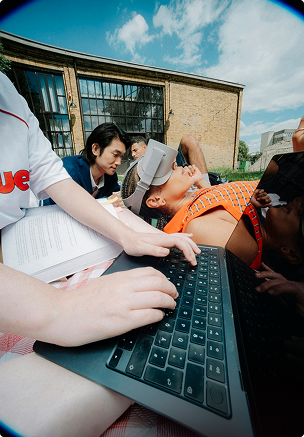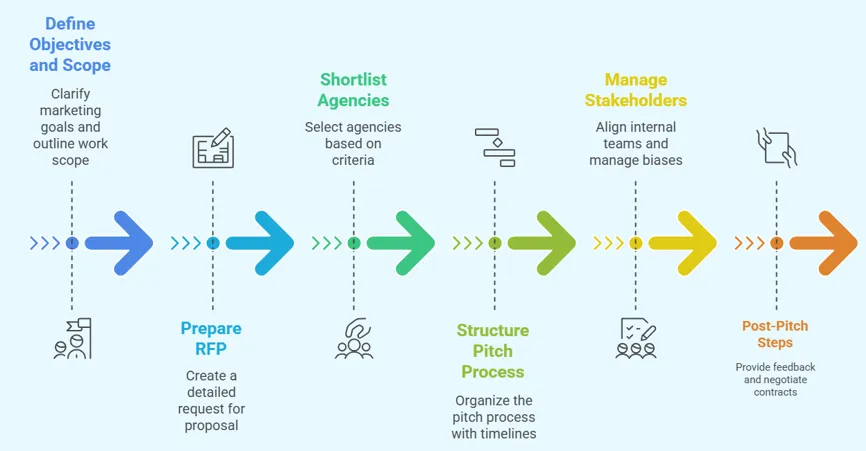






















When large organizations run a media agency pitch, it’s more than just a checkbox in the procurement process. It’s a chance to lock in the right partner for content creation, media planning, media buying, social media strategy, and media investment across all channels.
Yet many enterprise teams treat it like paperwork instead of a strategic move, and that’s a missed opportunity.
Nowadays, winning just 2% more RFPs can drive a major revenue impact. Enterprise teams already outperform mid-market companies, with a 47% average RFP win rate compared to 45%.
In this guide, you’ll find a clear framework that aligns stakeholders and strengthens your agency selection process.
We’ll cover:
P.S. Struggling with scattered vendors, unclear media prices, or an agency selection process that drags on? Fieldtrip is built to solve exactly that. We connect strategy, content creation, and media buying in one system so your pitch priorities turn into real results. Let’s talk.
Purpose: An agency pitch helps large organizations find the right partner for media buying, content creation, and strategy. It should be treated as a strategic decision, not a formality.
Define Goals and Scope: Start by setting clear KPIs and objectives. Outline a specific scope of work to shape better agency responses.
Build a Strong RFP: Include project goals, timelines, budgets, technical needs, and performance-based deliverables. Clear RFPs lead to stronger proposals.
Shortlist Smartly: Use RFIs and capability reviews to narrow the list. Focus on 3 to 5 agencies with relevant experience and cultural fit.
Structure the Pitch Process: Set timelines, define the format, and share scoring rubrics. Clear structure supports better comparisons and decisions.
Align Internal Teams: Involve marketing, procurement, finance, and legal early. Clarify who makes decisions to avoid delays and conflict.
Close Strong and Onboard Well: Provide feedback to all agencies. Secure a detailed contract with defined deliverables and set up clear communication tools for onboarding.
Avoid Common Mistakes:
Tips for Smoother Execution:
Fieldtrip’s Role: Offers a full-service system that covers strategy, media, and content. Helps enterprise teams streamline the pitch process and deliver measurable results.
An agency pitch is the structured process you use to find the right partner for strategy, media buying, content creation, or digital advertising. You’ll invite agencies to respond to a request for proposal with media strategy responses, case studies, and client testimonials. The goal is to choose an advertising agency that fits your objectives, budget, and procurement needs.
If you run a large organization, your process will look very different from a smaller business. SMBs may rely on quick client meetings and simple media rate discussions.
Your case looks very different.
You’ll likely involve multiple stakeholders, compliance checks, performance-framed case studies, and even media auditing services. This makes the enterprise pitch process more structured, with a stronger focus on efficiency and long-term media investment.
Now that you know what an agency pitch is, let’s break down the exact steps you need to run one successfully.

Start by clarifying what you want from the partnership. Are you focused on brand awareness, lead generation, media buying efficiency, or a blend of performance and content creation? Your goals shape the agency selection process, and vague direction can derail it quickly.
Only 23% of marketers are confident they track the right KPIs, which shows how easy it is to lose clarity. Research also proves that specific and challenging goals can drive up to 90% better performance than unclear ones.
That’s why you should define measurable targets early. Whether it’s campaign ROI, media rates, or content strategy outcomes, make sure success is easy to track.
Once your objectives and KPIs are clear, outline the scope of work. Be upfront about what exactly you need. The more precise you are, the smoother the procurement process will be, and the stronger the responses you’ll get in every media pitch.
Once your goals are clear, turn them into an RFP. This document sets the tone for your entire agency pitch. A weak RFP gets you vague proposals, while a strong one attracts targeted, thoughtful responses.
Studies from McKinsey show that businesses with clear, detailed RFPs are 40 percent more likely to achieve project success than those with poorly defined ones.
That’s why you should always include a company overview, project objectives, budget range, and timelines. You also need a clear scope of work translated into deliverables like media planning, content creation, or social media scheduling.
To sharpen responses, ask for performance-framed case studies, client testimonials, and media strategy responses.
At Fieldtrip, we always share relevant case studies in our RFP answers so you can get a clear picture of execution and outcomes before making decisions.
Below, we have shared an example:

Moreover, don’t skip the technical side. List requirements like integrations, compliance, or media auditing services so agencies can price digital media technical costs accurately.
Keep it clear but flexible, enough direction to guide proposals without limiting creativity. The best enterprise RFPs strike a balance, clear enough to guide the proposal, but flexible enough for creative and media strategy ideas to shine.
Once your RFP goes out, you’ll get more responses than you can manage. The key is building a smart shortlist. Focus on agencies with proven expertise, relevant industry experience, and strong case studies that show they can handle complex media management or content strategy.
Cultural fit also matters; you need partners who’ll work well with your internal teams.
But don’t overcrowd your shortlist. Three to five solid contenders give you enough variety without creating chaos. To filter faster, you can use a Request for Information (RFI), capability decks, or a quick review of credentials. These checkpoints help you confirm who deserves a spot before moving into full pitch mode.
Now that you’ve got your shortlist, it’s time to design the pitch process.
Start by setting clear timelines and milestones, Q&A sessions, proposal submissions, and final presentations. Agencies work better when they know exactly what’s expected and when.
Decide on the format early. Do you want in-person presentations, virtual sessions, or a hybrid mix? Each option has trade-offs, but clarity upfront saves everyone time.
Finally, make the process fair. Share a scoring rubric that explains how you’ll judge creativity, strategy, media planning, and content creation. When agencies know the criteria, they can shape their proposals around your priorities, and you’ll find it easier to compare responses side by side.
A successful media agency pitch depends on how well your internal teams work together. The CMO, procurement, brand leads, and even finance or legal need to align early. Without alignment, the process slows down and decision-making gets messy.
For example, a Forrester survey shows that companies where marketing, digital, engineering, and CX teams stay tightly aligned achieve revenue growth 1.6 times faster and customer retention 1.4 times higher than peers.
Internal politics and bias can surface quickly. One leader might favor a long-term partner, while another pushes hard on media prices.
Poor communication is often the root cause. In fact, more than 40% of teams cite it as the biggest obstacle to joint success between marketing and sales.
To keep things balanced, ground your discussions in the RFP criteria, case studies, and clear performance metrics.
Jake Jorgovan, a serial entrepreneur, explains it well:
“A big pitfall with RFPs… those who design and run RFPs are often not the ones who deliver the projects. They always started every project kickoff by clarifying what was in scope versus out of scope to their actual POCs, who are on the project. Otherwise, scope creep can be a huge problem.” (Jake Jorgovan, COO inBeat Agency)
So always make sure decision-making authority is clear. When everyone understands who has the final say, you reduce confusion, shorten debates, and keep the agency selection process moving smoothly.
Once the pitch wraps up, don’t go silent on the agencies you don’t pick. Send professional feedback that shows where they did well and where they fell short. It keeps relationships positive; you may want to invite them into a future media agency pitch.
Next comes negotiation. Lock in a clear media agency contract that spells out deliverables, media rates, reporting, and compliance. Avoid vague terms that leave room for scope creep. A solid contract template, backed by your legal and procurement teams, protects both sides and sets expectations early.
Of course, you can’t plan for every single task before a project starts. But you can make sure new requests are discussed openly and documented clearly. Transparent conversations help you avoid misunderstandings and keep the partnership strong.